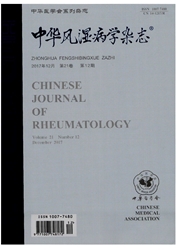

 中文摘要:
中文摘要:
目的:采用重组人快型肌球蛋白结合蛋白C(MYBPC2)免疫小鼠获得自身免疫性肌炎模型。方法将MYBPC2与完全弗氏佐剂乳化后,以皮下多点注射免疫C57BL/6小鼠(0 d、7 d),同时腹腔注射百日咳毒素2μg。①探索不同剂量MYBPC2免疫小鼠,在不同时点肌肉病理变化情况。②以600μg/次免疫小鼠,在第21天检测其肌肉耐力,观察肌肉组织主要组织相容性复合体(MHC)-Ⅰ类分子以及炎症细胞浸润等病理变化。采用Mann-Whitney U检验进行统计分析。结果①随免疫剂量增加,肌肉损伤和炎症趋于严重,在21、28 d肌组织损伤最显著,模型组小鼠肌组织可见肌纤维变性、坏死和炎细胞浸润。②小鼠模型组肌肉耐力[(6.1±1.3) min]与对照组[(9.2±1.6) min]相比明显下降(U=2.00,P=0.017)。模型组肌纤维表面MHC-Ⅰ类分子阳性,肌纤维间及血管周围区域可见散在CD4+及CD8+T细胞、CD68+巨噬细胞浸润,CD20+B细胞主要分布于血管周围区域,肌纤维间少见。结论在国内首次采用MYBPC2成功诱导小鼠自身免疫性肌炎。 MYBPC2诱导的新型自身免疫性肌炎模型具备人类多发性肌炎相似的临床和肌肉病理特征,能够作为研究肌炎发病机制的新型工具。
 英文摘要:
英文摘要:
Objective To establish a new murine model of experimental autoimmune myositis by immunizing with MYBPC2 protein. Methods The purified Myosin-binding protein C, fast type (MYBPC2) was emulsified with complete Freundˊs adjuvant, then C57BL/6 mice were immunized by multi-point subcutaneous injection (0, 7 days), and intraperitoneal injection of pertussis toxin 2 μg simultaneously. The pathological changes of mice with different immunizing dose at the preconceived time were ex-plored. Mean-while, mice were immunized with 600 μg each time, and the muscle endurance was tested on the 21th day. The expression of major histocompatibility complex (MHC) class-Ⅰ and the surface biomarkers of the inflammatory cells in muscle tissues were observed. Mann-Whitney U test was used for statistical analysis. Results ① With the increase of immunizing dosage, muscle damage and inflammation tended to be more serious. On the 21th and 28th day, muscle lesions were most significant. Muscle fiber degeneration and necrosis and inflammatory cell infiltration could be seen in the experimental group. ② Compared with the control group, muscle endurance of mice in the experimental group decreased significantly [(6.1 ±1.3) min versus (9.2±1.6) min, U=2.00, P=0.017]. The MHC class-Ⅰ on the muscle fiber surface of the experimental group was positive, scattered infiltration of CD4 +, CD8+ T ly-mphocytes and CD68 + macrophages between muscle fibers and around the vascular areas could be observed, and CD20+B lymphocytes mainly distributed in the area around the blood vessels, nevertheless rarely seen between muscle fibers. Conclusion Exper-imental autoimmune myositis models of mice have been successfully induced by immunizing with MYBPC2 in China for the first time, and similar clinical and pathological features of human polymyositis could be observed. This new model can be used for studying the pathogenesis of autoimmune myositis.
 同期刊论文项目
同期刊论文项目
 同项目期刊论文
同项目期刊论文
 Clinical Characteristics of Anti-3-Hydroxy-3-Methylglutaryl Coenzyme A Reductase Antibodies in Chine
Clinical Characteristics of Anti-3-Hydroxy-3-Methylglutaryl Coenzyme A Reductase Antibodies in Chine Cyclophosphamide treatment for idiopathic inflammatory myopathies and related interstitial lung dise
Cyclophosphamide treatment for idiopathic inflammatory myopathies and related interstitial lung dise Expression of tumor necrosis factor-like weak inducer of apoptosis and fibroblast growth factor-indu
Expression of tumor necrosis factor-like weak inducer of apoptosis and fibroblast growth factor-indu Enhanced formation and impaired degradation of neutrophil extracellular traps in dermatomyositis and
Enhanced formation and impaired degradation of neutrophil extracellular traps in dermatomyositis and 期刊信息
期刊信息
